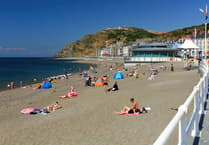A warning for unseasonably strong winds on Saturday has been upgraded to a fully fledged storm by the Met Office.
A yellow warning for strong winds along the west coast throughout Saturday was issued by forecasters on Thursday.
On Friday morning, the Met Office updated the warning, saying the impact of Storm Antoni will be greater than first thought and may cause disruption to outdoor events.
The yellow warning will run from 8am on Saturday until 8pm.
The Met Office says Storm Antoni will bring unseasonably windy weather, with injuries and danger to life from flying debris possible.
Injuries and danger to life could occur from large waves and beach material being thrown onto sea fronts, coastal roads and properties, the warning adds.
The full warning reads: "An area of low pressure, Storm Antoni, will bring unseasonably windy conditions to south and southwestern areas of England and Wales during Saturday.
"Strong winds are likely to affect Irish Sea coastal areas from early morning, pushing gradually south and east and spreading inland. By the afternoon English Channel coasts will also see some very windy conditions.
"Gusts of 35-40 mph are expected widely, with 50-55 mph along coastal stretches across the warning area. The strongest winds, however, will affect parts of southwest Wales and southwest England, where gusts could reach 50-55 mph inland for a time and perhaps 60-65 mph along exposed coastal areas and over high ground.
"Later in the afternoon and through the early evening, wind strengths will begin to slowly ease from the west."
Met Office Chief Meteorologist Steve Willington said: “Storm Antoni will bring some potentially disruptive weather on Saturday as it moves from west to east. Northern Ireland is likely to see some of the highest rainfall totals, with 40-60mm falling in some spots, but 20-30 more widely. Away from the warning area many will still see a very wet day, especially in north Wales and north England.
“Storm Antoni will also bring strong winds to a swathe of Wales, southwest England and southern coastal areas of England. The strongest winds will affect parts southwest England and southwest Wales where exposed coasts and high ground could see gusts in excess of 60mph. In these areas, gusts inland could reach 50-55mph for a time. These windy conditions will likely coincide with high tides which will present an additional challenge for coastal areas.
“Busy travel networks at this time of year and the possibility of people having made plans to be outside have resulted in the system meeting our criteria for naming, with a strong chance of disruption for those within the warning areas.”
The RAC’s Rod Dennis said: “We expect Saturday to be the worst day on the roads of the summer so far, especially for anyone in the southwest of England – and that’s a lot of people as our research shows it’s the most popular part of the country for leisure trips by car this year.
“Conditions will be atrocious with a wholly unpleasant mix of very strong winds and locally intense rainfall. The best advice is to slow down significantly to stay safe and avoid exposed moorland and coastal routes until the storm passes. Drivers towing caravans and trailers need to be particularly careful in these conditions and those with boxes and bikes on the roof should double-check they’re secured properly.
“Drivers should also watch out for fallen trees and be prepared for the disruption they cause.
“Nationally, we estimate around 4m drivers will be using the roads for leisure journeys across the whole weekend.”
We may however sample a taste of summer later next week as the jet stream moves slightly. Steve Willington explained: “For the latter half of next week, there are some signals of a shift in the jet stream which may allow for high pressure to build in for southern areas of the UK, increasing the likelihood of some drier weather for a time. However, at this range, the details are quite uncertain and there’s still a chance of some rain for areas further north. As always, details will become clearer with a shorter lead time.”





Comments
This article has no comments yet. Be the first to leave a comment.